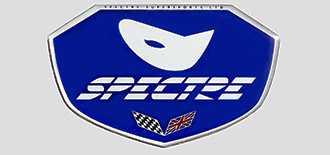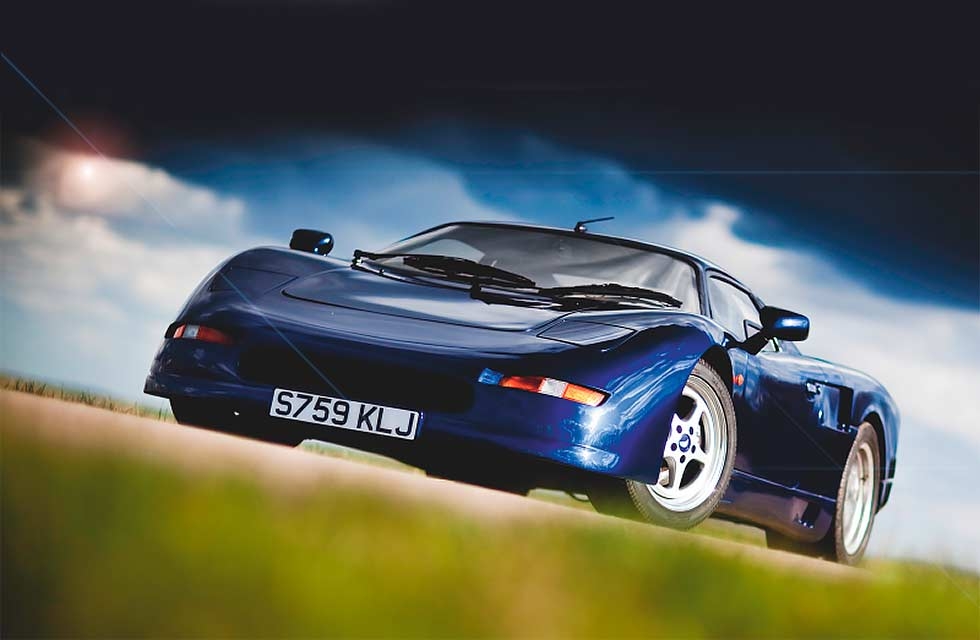
GT40 Reborn? Remembering the Spectre R42, a failed attempt to revive Ford’s icon May 2009. Could a Ford special, made in Dorset, muscle into the supercar set? Spectre’s R42 got closer than you’d think, says Alastair Clements. Photography Malcolm Griffiths.
Ghost of a chance
Try to suspend your disbelief for a moment and understand this: you’re looking at a Ford GT40. Not the four-times-Le-Mans-winning original, admittedly, but one man’s vision of a GT40 for the ’90s. And that man – Ray Christopher – knew a thing or two about Ford’s supercar, the GT Developments firm he co-founded having built c300 recreations before he began to dream up his own design in 1991.
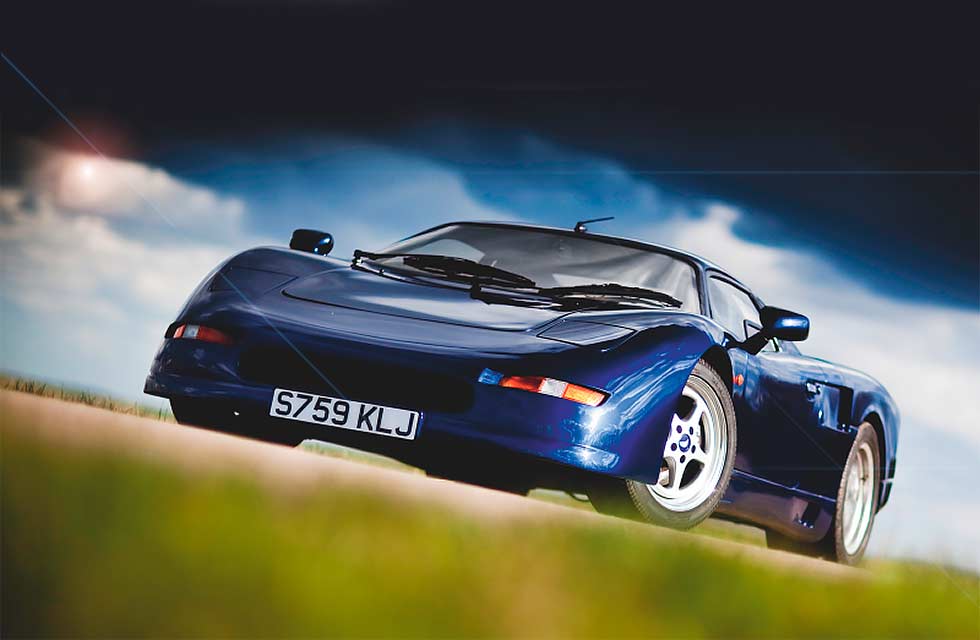
The proportions were similar, as was the layout – Ford V8 mounted amidships, ahead of a transaxle gearbox – and the underpinnings took the concept of the GT40’s monocoque and updated it with innovative folded aluminium and honeycomb composite construction. Even the name – R42 – paid homage to the original, the 42 referring to the height from the ground to the roof (although production cars stood 43 in high). The R, incidentally, was a touch of vanity from Ray. Christopher even planned to take the R42 to La Sarthe. “My ambition has always been to see my car going down the Mulsanne Straight at night,” he told the Dorset Echo. “If it does the first 12 hours I will be a happy man.”
NEITHER FRONT NOR REAR TYRES SHOW ANY SIGN OF RELINQUISHING THEIR GRIP ON THE ROAD
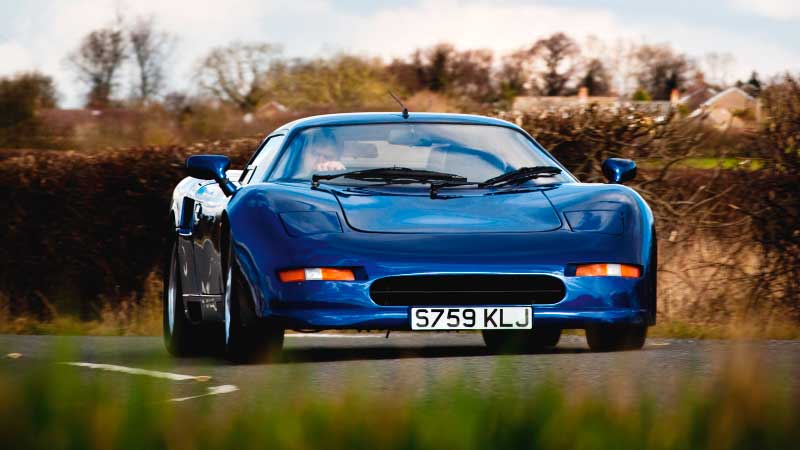
Before that could happen, he first had to build a road car. Having created a scale model and prototype chassis by the end of 1992, work began on the first running car, due to be unveiled at the London Motor Show in October 1993. That target was met, but the combination of development costs and a worldwide recession forced GTD into receivership late the following year. The firm was revived, but only after the rights to the R42 were sold for a reputed $2.5m to US-registered Spectre Motors Inc, led by 34-year-old former GTD Scandinavian sales agent Anders Hildebrand, in March 1995. Not only did Hilde-brand get the R42 into production just four months later at GTD’s Creekmore premises in Poole, Dorset, but he also secured dealerships in his native Sweden, plus England, Denmark and Belgium – and had US supercar maker Saleen keen to assemble R42s Stateside.
SEVERAL COWS, TWO TREES AND A 1994 FORD FIESTA GAVE THEIR LIVES TO FURNISH THE R42
Ever canny, Hildebrand engineered various high-profile stunts to keep Spectre in the public eye. In 1996 he persuaded sports-racing legend Derek Bell MBE to come aboard as chairman and development consultant, and announced the ALCO-Spectre racing programme with the R42 GTR. Later that year came the bold assertion that Spectre Supersports Ltd had sold its 26th R42, with plans to move to a 12,000sq ft premises in nearby Holton Heath and increase annual production to 200 cars within three years.
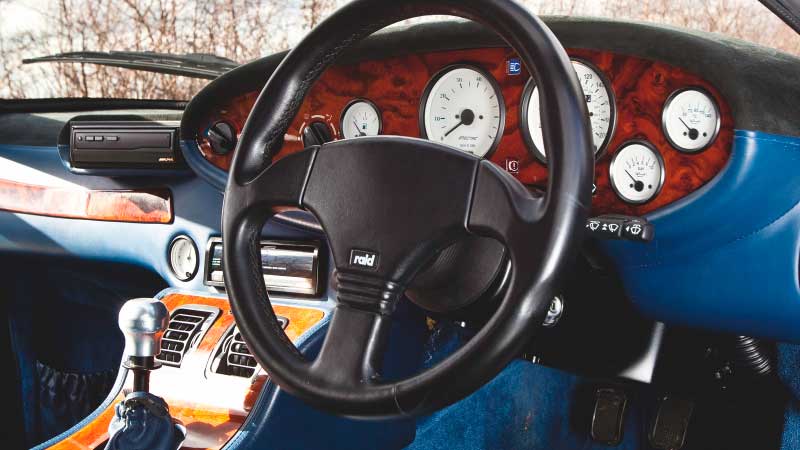
But Hildebrand’s greatest coup was yet to come. As 1997 dawned, two R42s were jumping, crashing, powersliding and chasing their way around the French Riviera alongside David Arquette, Malcolm McDowell and Goldeneye Bond girl Famke Janssen in RPM. This heist movie – complete with Jerry Hall cameo – about the theft of a revolutionary eco-friendly supercar promised much, but turned out to be a sub-Gone in 60 Seconds (remake) stinker. That meant the Spectre – chosen ahead of the McLaren F1 specifically because people wouldn’t know what it was – didn’t get the exposure Hildebrand craved. RPM went straight to video and has encouraged some spectacular online user reviews, such as: ‘The best bit of the movie was the credits. The worst bit was the 91 minutes before the credits,’ or, ‘The benchmark for all bad films.’
If past experience of low-volume, low-budget so-called supercars is anything to go by, the Spectre could be in line for similarly scathing criticism. And initial acquaintance with chassis 29, the last R42 built – some numbers were left unallocated, accounting for a build total of 23 – isn’t promising. GTD initially planned to use aluminium or carbonfibre, but Spectre’s switch to glassfibre didn’t prevent a pretty wobbly finish – perhaps because boat-builders laid the panel- work, or simply because the bucks were created from scaled-up scans of the 1:4 model!
Car described the R42 as ‘an example of how difficult it is to play Ferrari and Lamborghini’s game without players like Pininfarina and Gandini’, but perhaps that’s a little harsh. Christopher’s design is let down in the detailing: just adding some sculpture to the air intakes and swapping the parts-bin doorhandles for bespoke items would help. The nose blends MR2 indicators and de rigueur pop-ups fairly neatly, but to the rear it’s a jumbled concoction of vents, shutlines and ill-fitting Honda Legend lamps (albeit an improvement on the prototype’s Ford Orion units). The shape itself, however, is pretty accomplished: compact and well proportioned, mixing cues from a wide palette that includes Jaguar XJR-15, Ferrari 288 Evoluzione and Lamborghini Countach. It’s efficient, too, its Cd of 0.28 achieved with the aid of aerodynamics students at Stockholm University – another bit of Hildebrand lateral thinking – who did the sums taken from the scale wind-tunnel model as an interesting practical project.
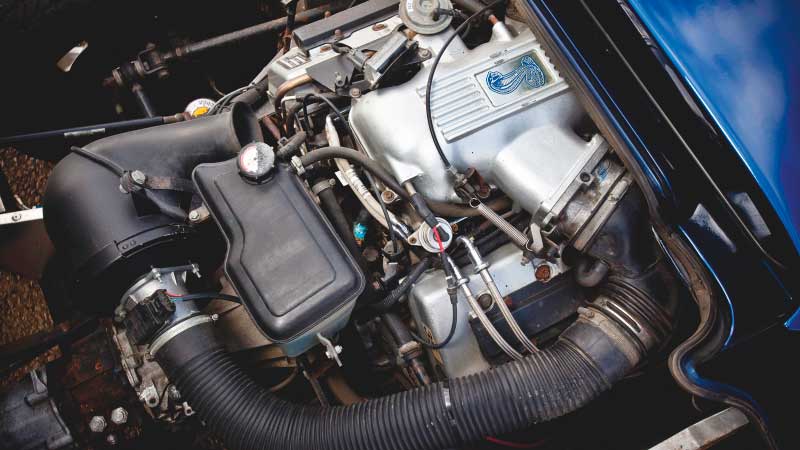
Any lingering doubts over the R42’s supercar credentials evaporate when you lift the engine cover (the entire rear end from the bulkhead back). Here it’s easier to fall for the GT40 illusion – or a GT40 for the new millennium, with Ford’s classic 289 replaced by its all-aluminium quad-cam ‘Modular’ 4.6, driving the vast rear wheels via a Getrag five-speed transaxle rather than its spiritual ancestor’s ZF. The hissing snake atop the V8’s plenum chamber marks out this R42 as a production car, powered by the Ford Mustang Cobra unit rather than the Lincoln MkVIII motor used in the first cars.
The Blue Oval theme continues inside. It’s clear that several cows, a couple of walnut trees and a circa 1994 Ford Fiesta gave up their lives to furnish what Spectre called its ‘Racing car in a dinner jacket’. The flashes of low-rent Dagenham plastic that pervade the cabin contrast with Wilton carpets, anti-glare Alcantara, bespoke white dials – including an impressive 200mph speedo – and the ruched blue leather of the slightly-too-reclined sports seats. Actually, they need to be at that angle to give enough headroom – although it’s the lack of legroom in this car that may cause complaint. Adjustable pedal boxes were offered, but chassis 29 appears to be designed resolutely for sub-six-footers: anyone taller will find that knees and knuckles have an uncomfortably close relationship.
Those poor knuckles also take a battering from the gearchange: unless you remember to take care as you engage first or third, your fist crashes into the centre console air vents – early-’90s Ford, naturally. But it’s best not to dwell on such things, for to do so would be to overlook one of the biggest motoring surprises of the past two decades. Because some 80% of the Spectre experience is actually pretty decent – no, that’s not fair, it’s genuinely bloody good.
First up, the R42 is unusual for its genre in that it doesn’t intimidate. The clutch is a bit heavy, but that knuckle-cracking gearchange is amazingly light considering the torque going through it and the gate – borrowed from the Lotus Esprit – is well defined for a cable set-up, probably due to the quality of the Getrag transaxle (developed for Audi). Then there’s the ride, which, despite the acreage of low-profile rubber, never crashes and gets more compliant as speed builds, without sacrificing body control. You can see out the back and, despite its potency, the 350bhp V8 is refined unless you’re really tramping on. Aside from the tyre roar and the droning air-con – those Countach-style slot windows are more about taking car park tickets than ventilation – it’s a relaxing cruiser: 80mph registers just 2500rpm, with the 4.6-litre lump little more than a distant grumble. With most early orders heading to Switzerland, you can thank its drive-by noise regs for that.
Refinement is all very well, but there’s not much point using an off-the-shelf power unit for a supercar unless it’s quick. Fortunately, the Cobra V8 is a gem. The maker’s 0-60mph claims -ranging from a ludicrous, F40-beating 3.7 secs to a still-unlikely 4.2 secs – seem beyond the R42’s standing-start capabilities. But that’s more to do with its weight – a plaque on the sill reveals that the prototype’s 1090kg had ballooned to 1550kg for full production – and once on the move the Spectre feels mighty rapid. Plant the throttle at pootling pace in second, third or fourth and the surge is immediate.
Past 3500rpm a second inlet manifold brings 16 more valves into play, at the same time introducing a stirring induction roar to join the hammering of the V8, which by then has finally started to give urgent, insistent voice. Third in particular has a happy knack of doubling your heart-rate as it brings distant specks into sharp focus: fortunately the huge discs and AP Racing four-pot calipers are similarly breathtaking, with unintrusive servo assistance giving great pedal feel once the pad compound warms up.
Neither is the R42 a straight-line specialist. The Raid steering wheel is frustratingly mounted just above centre, which makes it feel oval, but it’s otherwise a nice thing to hold. It operates a powered rack of rare fluency: light enough to make the car feel agile, weighty enough to give confidence; full of mid-corner feel, yet suffering barely any kickback. And the grip is of the oh-my-God variety: after the first roundabout you have to stop to check what rubber wraps those 17in OZ Racing split-rim alloys. (For the record, they’re big: 235/45 Pirelli P Zeros up front, and colossal 335/35s to the rear.)
With that kind of footprint you wonder what it’ll be like in the damp, particularly with 58% of the weight over the rear, but today – thankfully – is the best that spring has to offer and in these conditions the Spectre’s adhesion is awesome. Neither front nor rear show any sign of relinquishing their grasp on the Tarmac and traction out of corners is monstrous, so there’s nothing to fear from unleashing all 335lb ft of torque as soon as you can see through the apex.
We should have expected a good chassis, of course. Not only is it innovative – a Group C-style monocoque with composite honeycomb sandwich bonded into a riveted and bonded alunimium frame – but it was also inspired by a car that won Le Mans four times. And the fella brought in to ensure it went round corners properly, Derek Bell, went one better at La Sarthe.
A very decent junior supercar, then? Indeed, but also one that fulfilled its creators’ self-imposed brief: to be a supercar that was easy for a novice to drive, docile around town and, as Spectre’s brochures suggested, ‘a super sportscar that is no more expensive to maintain than a family saloon’. The R42 required oil and filter changes every 12,000 miles, rather than monthly ministrations by an overpriced exotics expert.
There is, however, rather a large elephant in the room: price. At launch in 1995, the R42 was stickered at £69,950 – £18k ahead of an Esprit S4S, £1705 more than an NSX and £1500 costlier than a Porsche 911 RS 964. And with the R42 taking more than 2000 man-hours to build, £70k wasn’t enough to stop Spectre losing money. In that price bracket, even Lotus knew that well-heeled buyers didn’t want to see comedy glassfibre matting in the fuel-filler flap, ripples in the roof, nor Fiesta keys – still with Ford badges – and wipers that lifted off the ’screen at 95mph.
Spectre Supersports returned to the drawing board and came up with the R45, a higher-tech, easier to assemble and better-quality product that, crucially, could be sold at a higher (£90,000) price. The R45 was unveiled by Desmond Llewellyn – better known as James Bond’s gadget expert Q – at the London Motor Show in October 1997, but the writing was on the wall. The Spectre coffers were empty and, with just two R45 prototypes completed, the firm went into receivership before the year was out.
In 1997, you’d need to really fall for the Spectre to put up with its many and varied flaws. But it’s not 1997 any more. And, now that its maker has finished with it, this car could be yours for a fraction of its original price. Without a badge in sight the Spectre seems almost ashamed of its origins, yet there is no shame in coming so close to greatness. Today, the R42’s rarity and ability make it a more intriguing prospect than the cars it struggled to match when it was new.
Clockwise, from above: wobbly finish doesn’t shout supercar; but ’80s signature split-rim OZ Racing alloys do; as does grippy, balanced handling. Right: MR2 indicators blend well into attractive nose.
Below: Ray Christopher (on right) pulls the covers off the alloy-bodied GTD R42 prototype. Bottom: at the RPM film premiere with its starring Spectre. Main: ill-fitting Honda Legend lights don’t help messy rear. Below: Spectre claimed 0-60mph in 4 secs, but it feels more like 5.5; pop-ups were dated by 1995. Top: Spectre family tree, from GTD40 via R42 to stillborn R45 prototype. Above: Spectre Supersports team poses with R42 road car and 550bhp GTR racer.
Thanks to Spectre Cars Ltd (01908 698138), and to painter Simon at Clays Vehicle Services (01908 616158)
SPECTRE R42
Sold/number built 1994-1998/23
Construction honeycomb-reinforced folded aluminium sheet monocoque with glassfibre body, steel roll-over bar and steel subframes
Engine mid-mounted, all-alloy 32v quad-cam 4603cc 90°V8, with electronic fuel injection
Max power 350bhp @ 5900rpm
Max torque 335lb ft @ 4850rpm
Transmission rear-mounted Getrag five-speed transaxle (optional six-speed), driving rear wheels
Suspension independent, at front by double wishbones, swivel joints, adjustable anti-roll bar rear inverted wishbones, parallel radius rods, anti-roll bar; rising-rate coil springs and adjustable Spax gas telescopic dampers f/r
Steering power-assisted rack and pinion
Brakes 11 ½ in (295mm) ventilated discs, with servo
Wheels/tyres 17in alloys, 235/45 ZR17 (f), 335/35 ZR17 (r) tyres
Length 13ft 6in (4115mm)
Width 6ft 1 in (1854mm)
Height 3ft 7in (1092mm)
Wheelbase 8ft 2in (2489mm)
Weight 3417lb (1550kg)
0-60mph 4.0 seconds
Top speed 175mph
Mpg 14
Price new £74,950 (1997 UK)

